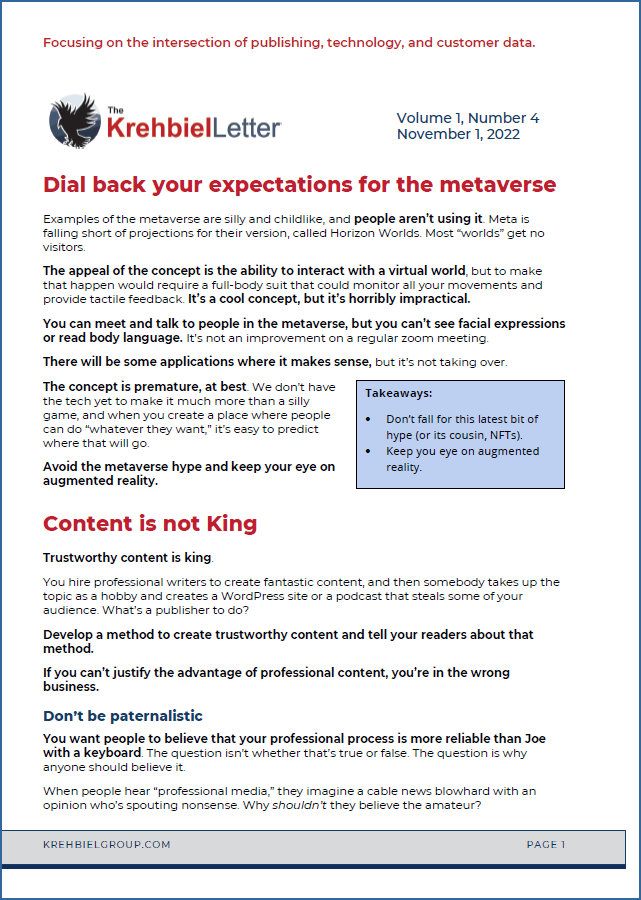General lessons about content marketing
How to come up with material
Always be listening. I have a good priest friend who says “when the student is ready, the teacher will appear.” I understand that to mean that there’s teaching going on all the time, all around us. We just have to have our ears tuned to hear it. Keep your subject matter in mind and listen for things that relate.
Use what you see and hear. For me, this mostly means …
- Bo Sacks articles
- Podcasts
- Guild discussions
- Industry meetings (Magic, Bold Minds)
- Conference agendas
- Webinars
- Industry events
Use what you learn in your work. Listen to what your clients, customers, and co-workers say, and what they struggle with. Think about how those things could help your readers.
Keep an ideas file handy and jot things down as they occur to you. I always have a pocket-sized notepad with me, and I keep a google doc called “ideas for the next Krehbiel letter.”
Keep particular readers in mind. Willard Kiplinger told his editors to write The Kiplinger Letter as if they were writing to a particular man in Ohio. You need to know the business of your readers and, as you encounter things, think about how they would affect your readers, and what they need to know.
Style
Cut the crap and get to the point. Use simple language and no jargon. Everyone hates jargon.
Focus on practical takeaways. There’s no end of fluffy stuff. Your job is to condense the world of noise into simple, clear concepts that will save people time and help them make money.
Poke fun at things. I expect people to laugh while reading my letter.
Write to be skimmed. I keep The Krehbiel Letter short, but I don’t assume everyone wants to read every word. Summarize. Highlight the key points.
Use lists, charts, and graphs where possible. This can be a struggle, because not everything is amendable to a visual representation, but I always keep it in mind as a goal.
Use stories and anecdotes. People remember stories better than lectures.
Have a unique voice and perspective. Don’t be afraid to ruffle feathers or attack sacred cows. It’s fine to be outrageous from time to time.
Seek Advice
Every suggestion or criticism has something you can learn. Sometimes it’s hard to find, but what your critic said made sense from their point of view. Try to get into that point of view and see what you can learn from it.
You can modify someone’s idea or suggestion. Your response doesn’t have to be yes or no.
Get help with design, layout, etc. I used Fiverr to get help with my Word template. I hired someone who’s a better programmer than me to help with my website. I hired another person to review my website and give me strategic suggestions.
Review Your Copy
Have someone else read each issue before you publish it. Sometimes you should pick a person who knows nothing about the subject matter. My kids have reviewed some of the issues.
Sleep on it. It’s amazing what your brain does in the background. Write articles ahead of time, let them percolate, and rewrite them a few times.
Ask ChatGPT to rewrite and/or summarize your article. It will give you new perspectives on your topic.
Reuse
Try to convert everything to another medium.
- Have long and short versions of articles.
- Have an article version and a version for a LinkedIn post.
- Turn your comments on LinkedIn, bulletin boards, etc., into articles, and vice versa.
- Create audio and video versions of your articles.
Print and Online
Make each medium the best it can be. Print should be the best print. Online should be the best online. Don’t try to find one format that works in both. That devalues each of them.
Online
- Use images
- Use links
- Allow yourself some space, if you need it
- Try to get comments / interaction / sharing
In print
- Use good paper
- Use color
- Use scents
Eat your own cooking
When you learn a best practice, do it. E.g., autoresponders for your email sign-up page. Show best practices by doing them yourself.
Make steady progress. I try to make each letter better than the last in some way. For example, with the April issue, I added a signature line.




